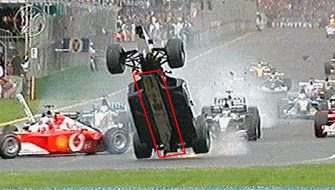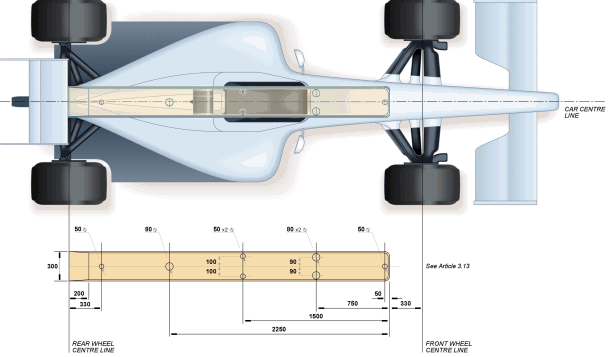Plank or skid block
 |
 |
Ralf Schumacher showing his 10mm thick wooden plank (Toyota 2006) |
A wooden or any other homogeneous material strip that was fitted front-to-back down the middle of the underside of all cars in the mid-1990s to check that cars were not being run too close to the track surface, something that was indicated if the wood was worn away. It must be made out of a material with a specific gravity of between 1.3 and 1.45 (to prevent excessively heavy or hard planks producing a performance benefits and lowering the car center of gravity). Typically the plank was wood based, made from a beech wood product called Jabroc, although more exotic blends of woods and resins not unlike MDF have been used. Today has moved over to a phenolic resin material called Permaglass made by "BTR Permali". This is a glass reinforced laminated product, so it's no any longer a wooden plank at all! The material has good fire resistance, produces little smoke and toxic fumes, making it ideal for its application in F1.
 Plank must measure 300mm in width, with a tolerance of 2mm. It must run from the frontmost point of the reference plane at 330mm behind the front wheels centerline to the rear wheels centerline. Skid block may comprise of no more than three pieces, the forward one of which may not be any less than 1000mm in length. Plank must be fixed symmetrically on the car centre line in such a way that no air may pass between it and the surface formed by the parts lying on the reference plane. The lower edge (facing ground) of the front end of the skid block may be chamfered at an angle of 30° to a depth of 8mm, and trailing, rear edge may be chamfered over a distance of 200mm to a depth of 8mm. On picture right, a piece of the floor "plank" propped up outside the Renault garage, note the various holes drilled within its surface for fixing it to the underside of the car and mounting the skids.
Plank must measure 300mm in width, with a tolerance of 2mm. It must run from the frontmost point of the reference plane at 330mm behind the front wheels centerline to the rear wheels centerline. Skid block may comprise of no more than three pieces, the forward one of which may not be any less than 1000mm in length. Plank must be fixed symmetrically on the car centre line in such a way that no air may pass between it and the surface formed by the parts lying on the reference plane. The lower edge (facing ground) of the front end of the skid block may be chamfered at an angle of 30° to a depth of 8mm, and trailing, rear edge may be chamfered over a distance of 200mm to a depth of 8mm. On picture right, a piece of the floor "plank" propped up outside the Renault garage, note the various holes drilled within its surface for fixing it to the underside of the car and mounting the skids.
When measured through six pre-cut 5cm diameter holes, plank has to have a tolerance of just 1mm on its 10mm thickness. Seven precisely placed holes in the plank allow the cars reference plane to sit directly and exactly on right place on the FIA scrutineering platform, for legality checks over the course of a GP weekend. Any holes made into it must conform to a FIA template (see picture below). Four further 10mm diameter holes are permitted provided their sole purpose is to allow access to the bolts which secure the Accident Data Recorder to the survival cell.
With the current rake angle set ups the front of the plank is fitted with titanium fasteners to mount the plank and resist wear as the plank rubs along the track. In addition, teams bond the plank to the floor with a semi-permanent glue, although the regulations do state the plank can only be fastened with the predefined fittings. Both the titanium fittings and the glue layer appear to be allowed by the FIA. Although the skid block material is now specified as Titanium rather the previous used tungsten, the latter of which is denser and heavier, more wear resistant and produces few sparks. That is the reason why we can see firework from under the car.
If plank is consumed too much, car can be disqualified. Skid block or 'plank' must run along the reference plane. It is not considered part of the floor for measurement purposes, and is there only to enforce a minimum ride height.
Plank was introduced with intention of FIA to reduce aerodynamic capabilities and bottoming of the cars, following Austrian Roland Ratzenberger death in qualifying for the San Marino Grand Prix in 1994 driving his Simtec, and Ayrton Senna in a Williams car at the San Marino Grand Prix same year during the race.

3.13.2 The lower surface of the plank may be fitted with flush mounted metal skids which :
1. a) May only be fitted in place of plank material.
2. b) Have a total area no greater than 20000mm² when viewed from directly beneath the car.
3. c) Are no greater than 4000mm² in area individually when viewed from directly beneath the car.
4. d) Are fitted in order that their entire lower surfaces are visible from directly beneath the car.
5. e) Must have a minimum cross sectional thickness of 15mm across its external boundaries in plan view. The minimum wall thickness between an internal fixing hole and the external boundaries of the skid must be no less than 7.5mm.
6. f) Must have an upper surface no more than 3mm below the reference plane.
7. g) Must be designed such that they are secured to the car using the fasteners described in 3.13.3 and that, when viewed from directly beneath the car, no part of the skid is more than 50mm from the centreline of a fastener which passes through that skid.
8. h) Must be made from Titanium alloy.
3.13.3 The plank and skids must be fixed to the car using fasteners which :
12. a) Are no smaller than M6 and are made from grade 12.9 steel.
13. b) If used to attach a skid to the car, must employ at least 1 fastener per 1000mm2 of skid area.
14. c) If used to attach a skid to the car, the team must be able to show by calculation that the shanks of the fasteners (which may be no less than 6mm diameter) are the weakest point in the attachment of the skids to the car.
15. d) May use a load spreading washer if required. The total area of the fasteners and any load spreading washers employed with them when viewed from directly beneath the car must be less than 5000mm2. The area of any single fastener plus its load spreading washer may not exceed 500mm2. No part of any fastener or load spreading washer may be more than 8mm below the reference plane. For the avoidance of doubt, the skids referred to in 3.13.2 will not be treated as load spreading washers.
Back to the top of the page






